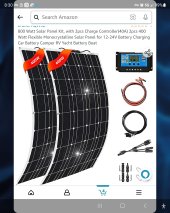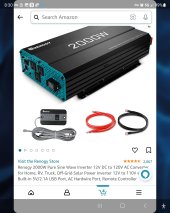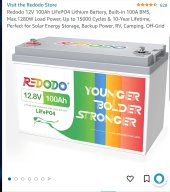We have that inverter, flexible panels (on top of a camp trailer roof) but not that battery.
What I've read about the Redodo battery is it seems to have more or less decent reviews (people like it because it's cheap), BUT it doesn't have low-temp charging cut-off protection. If there's ever a chance that your temps could get near or below freezing, skip all the cheap batteries that don't have low-temp protection (and some that claim to have it do not work as advertised, as Will Prowse shows in his tear down videos that
@HRTKD linked to). If you charge a frozen or partially frozen lithium battery, you will cause irreversible damage to the battery.
The 2000W Renogy inverter has served us well, but I would not buy it again. It also comes with woefully inadequate cables, you would want 2/0
cables like these. I think we got it on an "open box" deal from the Renogy ebay store, so it was a good deal, but what I don't like about it is the high idle draw. Which means that when it is simply turned on and not actually powering anything, it uses 24W. Which means that if you leave it turned on 24/7, you will use (24w X 24hours)=576 watt-hours. The Redodo battery you show (and any other 12v 100Ah battery) contains 1280 watt-hours (Wh) of energy. Which means if you simply have the 2000W Renogy inverter turned on, without it powering anything, it will use
45% of your battery in 1 day! We have a small fridge that we need to keep on 24/7. Now if you have enough solar panels and big enough charge controller to account for that, it's not a big deal, but you could save some money (with fewer panels and smaller charge controller) by simply getting a different inverter. It will also save you on not needing to buy quite as big of a battery bank.
There are more efficient inverters out there (more $) but in general...the bigger the inverter, the bigger the idle draw. a 1000W inverter will draw roughly half of a 2000W one, but like I said, some inverters have lower idle draw for the same wattage, because they were better designed/built.
You will often read that newbies first buy an inverter that is too small and regret it. Well, it can go the other way, too...you can buy an inverter that is simply too big for what you actually need and use. If you want a bigger inverter simply because you
might want to run something high powered one day or
might want to feel free to run multiple 500W devices at once, then you will pay for that every day in an inverter that has a high idle draw.
The cheapest way to reduce the idle draw is to buy a smaller inverter. If you do an "energy audit" (instructions found elsewhere on this forum or google), you will have a better idea of what each item you intend to run from the inverter will use. If it's something like a space heater, those typically draw 1500W, without a big startup rush of current (like an air conditioner or fridge). If you intend to run a typical fridge (that doesn't have one of the newer/fancy 'inverter compressors'), then while the fridge might only draw 100W or less when running, it can use 800 to 2000+W when it first starts up for about 1 second. If you don't have one yet, get a Kill-a-Watt type of meter and run your devices on it for a while to get an idea of how many watts each device uses.





